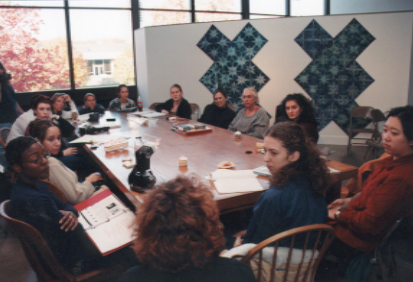Connie Samaras

Photo By Adriana
Yugovich
|
By Heidi
Gjengdahl
What is your relationship
to feminism? That was the question that was posed by Connie
Samaras upon her arrival at the University of Michigan. This
happens to be a question that I have been struggling to come
up with an answer to for some time. I don't think that I can
simplify it to the bumper sticker mentality that "Feminism
is the radical notion that women are people too." In some
ways that is a contemporary radical notion because it was in
this century that women gained the right to vote, but I
think there are more layers to it than that. It is not just
the notion that women are people but that they have rights
to fair and equal treatment and representation as
people.
There seems to be a
difference in the approach to feminism in the 90s versus the
70s when the women's movement was blossoming and strong.
Women aren't burning their bras anymore, they are buying
Wonder Bras and still calling themselves feminists. Does
feminism lie in the clothes we choose to wear, or not wear?
Look at the Spice Girls. They bare their flesh, wear
tight-fitting clothes, and shake their booties at will. They
proclaim "Grrrl Power" as their motto. Is this a marketing
ploy to further uphold the stereotypes of women as objects,
(Barbie with a slogan?), or is this the face of 90s
feminism?
|
Much of what is currently being labeled as
feminist thinking has to do with the sexual power of women, giving
two thumbs up to cropped baby-tees as a display of personal
empowerment. Todays young women are not having the same experience as
70s feminists had. Many of the walls present before have been broken
down and are taken for granted now. Perhaps there are more walls
being put up that 90s feminists will have to deal with.
Although I was too young to be an active
particip ant in the women's movement of the 70s, my recollection is
that the labels of "woman" and "lesbian" were important to the people
involved. These labels were used to proclaim and redefine an
identity, and feel empowered by that identity. If Samaras is
representative of what feminism in the 90s looks like, than these
labels are no longer needed. For her images click here for
feminist and lesbian representation.
Samaras, who considers herself a progressive
feminist, would like to see the notion of gender smashed. What would
the world look like if that were the case? I have always been
uncomfortable with the definitions of what equals masculine and what
equals feminine. That implies some innate predisposition to the color
blue or pink. Or in art history it refers to the hard-edged shapes of
David Smith versus the soft-edged shapes of Barbara Hepworth. I'm not
all that fon d of pink and I like both squares and circles. Samaras
wants to not just redefine gender but to obliterate the area
inbetween the polar opposites of male/female, gay/straight. By doing
this, she suggests that room is made for groups of people that have
otherwise been marginalized and whose experiences have not been
included in writings of history, or recognized as part of the social
structure.
In Samaras' project on correcting the
information sent into space on the 1977 United States Voyager space
probes, she corrects old categories and creates new catgories of
earth culture that were not included in the original information. The
original information was presented from a white, eurocentric male
perspective and presented a narrow view of life on earth. Samaras
wants to broaden and challenge that view. There is a vast human
experience beyond the white, straight, middle-class male perspective
that needs to be recognized and valued. It is my impression that 90s
feminism has expanded to take up the fight not just for women's
rights but for the rights for free expression of sexual identities as
well, be it male, female, transgender, bisexual, straight, lesbian,
or gay. This is echoed in Samaras' work.
What is my relationship to feminism? At times I
cradle it and other times I hold it at arms length and examine what
it is doing and how it fits in with my life. As the social structure
continues to change, feminism will have to too. There are still women
being exploited, raped, and abused in numerous ways. The work of
feminists is far from over, and Samaras continues to draw new lines
in the sand that challenge power structures and need to be dealt
with.
Also, Samaras tells radical narratives on
humans and aliens.
Her work has been exhibited and published internationally and
cyberspatially, and she is a co-editor of a forthcoming book and
CD-ROM titled Terminals.

Photo by Adriana
Yugovich
|
School
of Art and Design Home Page|
Women's
Studies Home Page|
Index|
Connie
Samaras's Images

